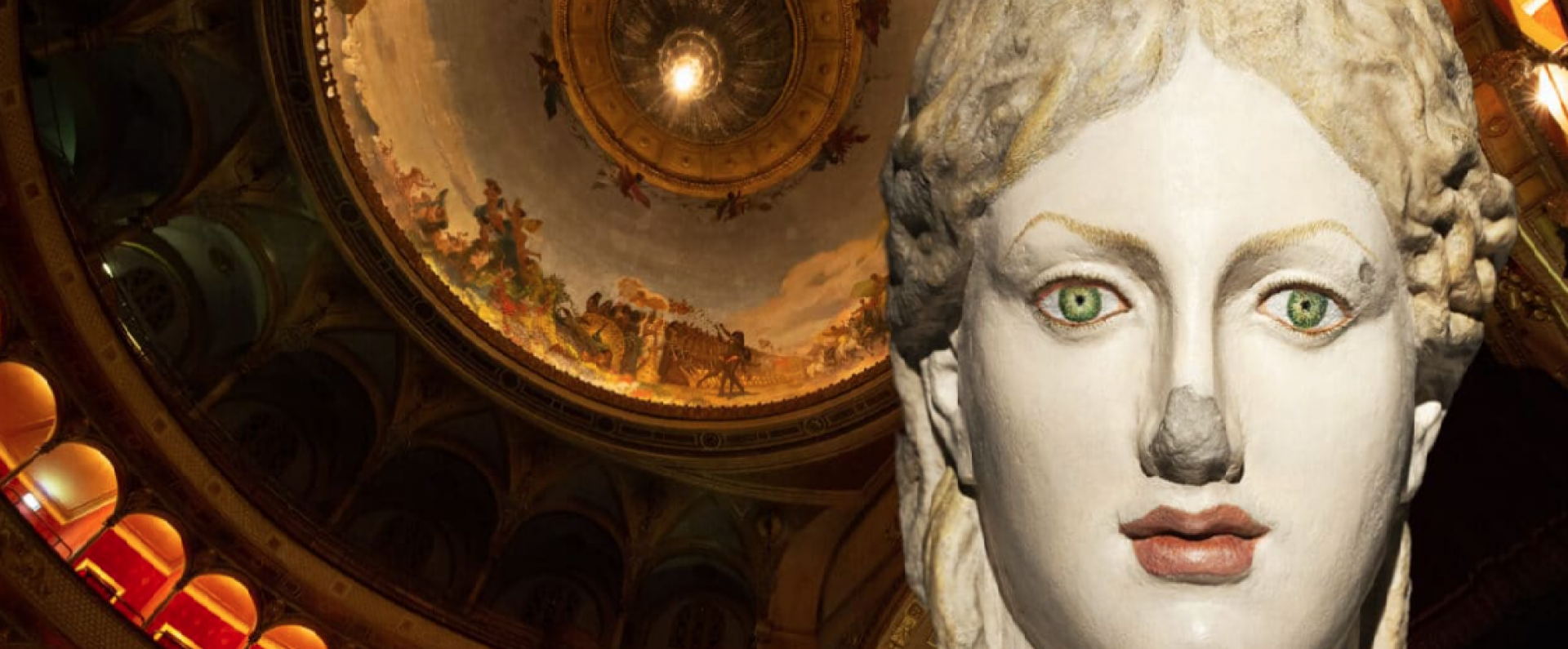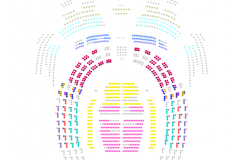Lucrezia Borgia
February 2025 | ||||||
|---|---|---|---|---|---|---|
Mo | Tu | We | Th | Fr | Sa | Su |
Synopsis
Time: Early 16th century
Place: Venice and Ferrara
Prologue
Scene 1
The Palazzo Grimani in Venice
Gennaro and his friends, including Orsini, celebrate on the brightly lit terrace, in front of which lies the Giudecca Canal ("Bella Venezia!"). The friends' conversation turns to Don Alfonso, Duke of Ferrara, to whose house they will be travelling the next day, and to his wife, the infamous Lucrezia Borgia. On hearing Lucrezia's name, Orsini tells of how Gennaro and he, alone in a forest, were warned by a mysterious old man to beware her and the entire Borgia family, and that the two of them would die together ("Nella fatal di Rimini"). Professing his boredom with Orsini's tale Gennaro wanders off and falls asleep nearby. His friends are invited to rejoin the festivities, and he is left behind ("Senti! La danza invitaci").
Scenes 2 and 3
A gondola appears, and from it a masked woman exits onto the terrace ("Tranquillo ei posa..."). She observes the sleeping Gennaro with affection and hurries over to him ("Com'è bello! Quale incanto in quel volto onesto e altero!"). When she kisses Gennaro's hand, he wakes and is instantly struck by her beauty ("Leggiadra e amabil siete"). He expresses his love for her, but admits that the one person nearer to him is his mother that he has never met. He sings of his childhood as an orphan brought up by a common fisherman father ("Di pescatore ignobile esser figliuol credei"). The woman, sympathetic to his plight, weeps for him ("Ama tua madre, e tenero sempre per lei ti serba...").
The others return ("Gente appressa... io ti lascio") and seem to recognise her, listing in turn the members of their families she has killed, to Gennaro's horror and disbelief ("Maffio Orsini, signora, son'io"). Gennaro is then finally told that the woman is Lucrezia Borgia.
Act 1
Ferrara
The Duke, believing Gennaro to be Lucrezia's lover, plots his murder with his servant Rustighello ("Vieni: la mia vendetta è meditata e pronta"). Gennaro and his companions leave the house for a party and pass the Duke's palace with its large gilded coat of arms reading Borgia. Keen to show his contempt for the Borgia family, Gennaro removes the initial "B", leaving the obscene "Orgia" (orgy).
In the palace, Lucrezia is shown into the Duke's chamber. Having seen the defaced crest, she demands death for the perpetrator, not knowing that it is Gennaro. The Duke orders Gennaro to be brought before her and accuses him of staining the noble name of Borgia, a crime to which he readily confesses. Lucrezia, horrified, attempts to excuse the insult as a youthful prank, but Don Alfonso accuses Lucrezia of infidelity, having observed her meeting with Gennaro in Venice. In a scene full of drama and tension, she denies any impropriety, but he demands the prisoner's death and forces her to choose the manner of Gennaro's execution. Pretending to pardon him, the Duke offers Gennaro a glass of wine and he swallows it. After a stunning trio ("Guai se ti sfugge un moto, se ti tradisce un detto!") the Duke leaves and Lucrezia hurries to Gennaro, giving him an antidote to the poison the Duke has mixed with the wine. He drinks, and in a last duet, she implores him to flee the city and her husband ("Bevi e fuggi... te'n prego, o Gennaro!").
Act 2
The palace of the Princess Negroni
Ignoring Lucrezia's advice, Gennaro attends a party at the palace, swearing never to be parted from his friend Orsini. Orsini leads the party in a brindisi or drinking song ("Il segreto per esser felici") and they drink. Lucrezia enters and announces that in revenge for their insults in Venice she has poisoned their wine and arranged five coffins for their bodies. She has hitherto believed that Gennaro fled Ferrara on her advice, and is thus dismayed when he steps forward and announces that she has poisoned a sixth. Orsini, Liverotto, Vitellozzo, Petrucci and Gazella fall dead. Gennaro seizes a dagger and attempts to kill Lucrezia, but she stops him by revealing that he is in fact her son. Once again she asks him to drink the antidote, but this time he refuses, choosing to die with his friends. In a final cabaletta ("Era desso il figlio mio"), Lucrezia mourns her son and expires.
Program and cast
Music Gaetano Donizetti
Opera in a prologue and two acts
Libretto by Felice Romani after Victor Hugo
Conductor: Roberto Abbado
Director: Valentina Carrasco
Chorus Master: Ciro Visco
Set Designer: Carles Berga
Costume Designer: Silvia Aymonino
Light Designer: Marco Filibeck
CAST
Alfonso I D’Este: Alex Esposito / Carlo Lepore 19, 21, 23 Feb
Lucrezia Borgia: Lidia Fridman / Angela Meade 19, 21, 23 Feb
Gennaro: Enea Scala / René Barbera 19, 21, 23 Feb
Maffio Orsini: Daniela Mack / Teresa Iervolino 19, 21, 23 Feb
Don Apostolo Gazella: Arturo Espinosa
Ascanio Petrucci: Alessio Verna
Oloferno Vitellozzo: Eduardo Niave *
Gubetta: Roberto Accurso
Rustighello: Enrico Casari
Astolfo: Rocco Cavalluzzi
* graduated “Fabbrica”, Young Artist Program del Teatro dell’Opera di Roma
Teatro dell’Opera di Roma Orchestra, Chorus and Ballet Company
Teatro dell’Opera di Roma new production
Teatro dell´Opera di Roma Teatro Costanzi
A new way to discover the finest details in different opera houses, theatres one can explore from home in advance through the revolutionary GOOGLE PERFORMING ARTS PROJECT. CLICK ON THE LINK TO SEE THE THEATER.
The Teatro dell'Opera, from its building (1879), at Domenico Costanzi’s request (1810-1898), and 1926, when it was bought by the then Governor of RomE, bore the name of Domenico Costanzi, building contractor and impresario, who committed the building to the Milanese architect Achille Sfondrini (1836-1900), specialized in theatre building and renovation. Built in 18 months on the area prevIously occupied by Heliogabalus’ villa, it was inaugurated on November 27th, 1880 with Semiramide by G. Rossini, conducted by the Maestro Giovanni Rossi, in the presence of the King and Queen of Italy.
Sfrondini’s design privileges the acoustic effect, by conceiving the interior structure as a "resonance chamber": as is particularly evident from the horseshoe shape. At the beginning, the theatre, with a seating capacity of 2,212 spectators, had three tiers of boxes, an amphitheatre, a gallery. All was surmounted by a dome with splendid frescoes by Annibale Brugnoli.
Costanzi invested all his personal assets in the venture. However, due to the despotic refusal of the City Council to redeem the theatre, Costanzi was obliged to manage it himself. Despite the fact that he had to deal with huge financial problems, under his management the opera house held many world premières of such operas as Cavalleria Rusticana (on May 17th, 1890) and L'Amico Fritz(October 31st 1891), both by Pietro Mascagni, who then became very well known.
For a brief period, the theatre was managed by the founder's son, Enrico Costanzi, who contributed to other great premières: Tosca by Giacomo Puccini (January 14th, 1900) and Le Maschere (January 17th, 1901). In 1907, the Teatro Costanzi was managed by the impresario Walter Mocchi (1870-1955) on behalf of the Società Teatrale Internazionale e Nazionale (STIN).
In 1912 Emma Carelli (1877-1928), Mocchi's wife, became the managing director of the new «Impresa Costanzi», named as such following various changes in the company structure. With Rome City Council’s purchase of Costanzi company, the theatre became “Teatro Reale dell'Opera” and a partial rebuilding was commissioned to the architect Marcello Piacentini. Closed on November 15th, 1926, it was re-opened on February 27th, 1928 with the opera Nerone by Arrigo Boito, conducted by the Maestro Gino Marinuzzi.
With the advent of the Republic, the theatre gained the current name of Teatro dell'Opera. In 1958, the building was further remodeled and modernised at the request of the Rome City Council. In over a century, the Teatro dell’Opera has seen its prestige increase internationally. During the several seasons, the most acclaimed voices worldwide followed one another: Enrico Caruso; Beniamino Gigli; Aureliano Pertile; Giacomo Lauri-Volpi; Claudia Muzio; Maria Caniglia; Maria Callas; Renata Tebaldi; Montserrat Caballé; Marilyn Horne; Raina Kabaivanska; Mario Del Monaco; Franco Corelli; Giuseppe Di Stefano; Tito Gobbi; Alfredo Kraus; Ruggero Raimondi; José Carreras; Placido Domingo and Luciano Pavarotti. Among the finest conductors, we can mention Otto Klemperer, Arturo Toscanini, Victor De Sabata, Marinuzzi,Vittorio Gui, Tullio Serafin, Von Karajan, Gianandrea Gavazzeni, Carlo Maria Giulini, Georg Solti, Claudio Abbado, Georges Prêtre, Zubin Mehta, Lorin Maazel, Mstislav Rostropovich, Giuseppe Patanè, Giuseppe Sinopoli, Wolfgang Sawallisch, Nino Sanzogno, Gianluigi Gelmetti and since 2008 the Maestro Riccardo Muti.
How to reach Teatro dell'Opera
Piazza Beniamino Gigli, 7
METRO
Linea A - REPUBBLICA TEATRO DELL'OPERA stop
BUS
Via Nazionale - H, 40, 60, 64, 70, 71, 170, 116T
Via Depretis - 70, 71
Via Cavour - 16, 75, 84, 150 (festivo), 360, 590, 649, 714
Stazione Termini - 16, 38, 75, 86, 90, 217, 310, 360, 649, 714
TAXI
phone number - 06.3570

 EN
EN DE
DE IT
IT FR
FR ES
ES RU
RU JP
JP RO
RO
 Seating plan
Seating plan 